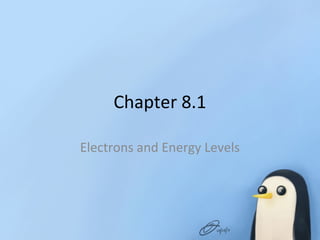
Chapter 8.1: Electrons and Energy Levels
- 1. Chapter 8.1 Electrons and Energy Levels
- 2. Periodic Table • Shows: – Elements – Atomic Number – State of matter at room temperature – Atomic (average) Mass
- 4. Periods and Groups • • • • Period = Rows Groups = Columns Lists elements in order of atomic number Atomic number increases as you move from left to right • Elements in each group have similar chemical properties and react with other elements in similar ways
- 6. Metals, Nonmetals, and Metalloids • Metals – Often shiny – good conductors of electricity and thermal energy – Easily pulled into wires and hammered into sheets • Metalloids – Have properties in common with both metals and nonmetals – Often used as semiconductors in electronic devices • Nonmetals – Poor conductors of thermal energy and electricity – Most are gases at room temperature – Solid form tends to be brittle
- 8. Atoms Bonds • Pure elements are rare to find • Atoms of different elements chemically combine and form compounds. • Compounds make up all living and nonliving things • Chemical bonds hold together different elements in chemical compounds • A chemical bond is a force that holds two or more atoms together
- 9. Electron Number and Arrangement • The exact position of electrons in an atom cannot be determined. • Electrons are in constant motion around the nucleus • However, each electron is usually in a certain area of space around the nucleus • Some are in areas close to the nucleus, and some are in areas farther away
- 10. Electrons and Energy • Different electrons in an atom have different amounts of energy. • An electron moves around the nucleus at a distance that corresponds to its amount of energy • Areas of space in which electrons move around the nucleus are called energy levels • Electrons closet to the nucleus have the least amount of energy – They are at the lowest energy level – Only 2 electrons can be in the lowest energy level
- 12. Electrons and Bonding • Negatively charged electrons have a similar attraction to the positively charged nucleus of an atom (like a magnet) • The electrons in the energy levels closest to the nucleus of the same atom have a strong attraction to that nucleus • Electrons farther from that nucleus are weakly attracted to it. – These outermost electrons can easily be attracted to the nucleus of the other atoms • This attraction between the positive nucleus of one atom and the negative electrons of another is what causes a chemical bond.
- 14. Valence Electrons • Electrons farthest from their nucleus are easily attracted to the nuclei of nearby atoms. • These outermost electrons are the only electrons that can form chemical bonds – This is because these electrons are exposed to the nuclei of other atoms • A valence electron is an outermost electron of an atom that participated in chemical bonding. • Valence electrons have the most energy of all electrons in an atom.
- 16. Valence Electrons • The number of valence electrons in each atom of an element can help determine the type and the number of bonds it can form. • The periodic table can tell you how many valence electrons an atom has. • Except for Helium, elements in certain groups have the same number of valence electrons • In groups 1,2, 13-18, the number of valence electrons is shown by the ones digits of the group. – So, elements in group 18 have 8 valence electrons.
- 17. Electron Dot Diagrams • In 1916, an America Chemist named Gilbert Lewis developed the electron dot diagram. • The electron dot diagram is a model that represents valence electrons in an atom as dots around the element’s chemical symbol • It can help you predict how an atom will bond with other atoms • The dots represent the valence electron • Some dots pair up, others do not • The number of unpaired dots is often the number of bonds an atom can form • See Figure 5, pg 271
- 20. Valence Electrons • Remember that each element in a group has the same number of valence electrons. • SO, every element in a group has the same number of dots in its electron dot diagram • Atoms with 8 valence electrons do not easily react with other atoms – They are chemically stable • Atoms that have 1-7 valence electrons are reactive of chemically unstable – They easily bond with other atoms and form chemically stable compounds • Atoms of H and He have only one energy level – These atoms are chemically stable with two valence electrons
- 21. Noble Gases • Elements in Group 18 are called noble gases • With the exception of He, noble gases have eight valence electrons and are chemically stable. • Chemically stable atoms do not easily react, or form bonds, with other atoms
- 22. Stable and Unstable Atoms • Atoms with unpaired dots in their electron dot diagram are reactive, or chemically unstable. • For example, N has 5 valence electrons are 3 of them are unpaired. – It is reactive and will become more stable by forming chemical bonds with other atoms • When an atom forms a bond, it gains, loses, or shares valence electrons with other atoms. • By forming bonds, atoms become more chemically stable
